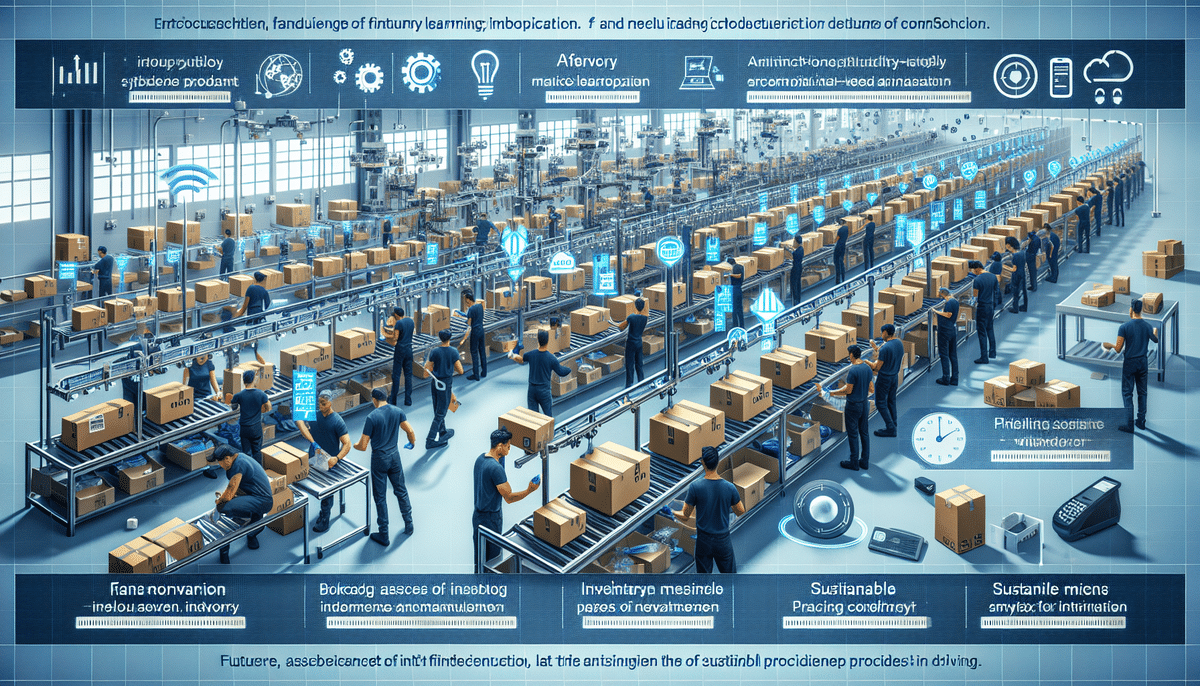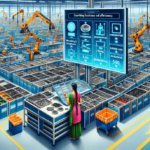Maximizing Efficiency with Product and Material Kitting
In today’s fast-paced business environment, maximizing efficiency is crucial for success. One effective method to enhance efficiency in manufacturing and distribution is through product and material kitting. This article delves into the definition of product and material kitting, its benefits, various types, implementation strategies, best practices, the significance of inventory management, its impact on supply chain management, common challenges, the role of technology, real-life case studies, and future trends.
What is Product and Material Kitting?
Product and material kitting is the process of grouping together all the necessary components or materials needed for a particular job or order. The goal of kitting is to streamline the assembly process by reducing the time spent locating and gathering required items. These kits can be created for a wide variety of uses, such as assembly lines, construction sites, and retail displays.
Kitting can also help reduce waste and improve inventory management. By pre-packaging materials in specific quantities, it becomes easier to track inventory levels and avoid overstocking or understocking. Additionally, kitting minimizes waste by ensuring that only the necessary materials are used for each job, reducing the amount of excess or unused materials that may end up being discarded.
Benefits of Product and Material Kitting
Kitting provides several benefits for businesses, including:
- Increased Efficiency: Streamlines the assembly process, reducing time and labor costs.
- Reduced Lead Times: Speeds up production by having all components readily available.
- Improved Accuracy: Minimizes errors in assembly by ensuring all necessary parts are included.
- Reduced Waste: Limits excess materials, contributing to cost savings and sustainability.
- Improved Inventory Management: Facilitates better tracking and control of inventory levels.
- Reduced Handling Costs: Lowers costs associated with moving and storing individual components.
- Enhanced Customer Service: Leads to faster delivery times and higher product quality.
Additionally, kitting can streamline supply chain processes. By grouping all necessary components for a product or project, businesses can reduce the number of steps in production, saving time and money. According to a Supply Chain Digital report, companies implementing kitting have seen up to a 30% improvement in overall supply chain efficiency.
Moreover, kitting contributes to reducing environmental impact. By optimizing inventory management and minimizing waste, businesses can lower their carbon footprint and support sustainable practices.
Types of Product and Material Kitting
There are different types of kitting, including:
- Standard Kitting: Pre-set kits that include the same items every time, commonly used for assembling identical products repeatedly.
- Dynamic Kitting: Kits created on-the-fly, tailored to each order's specific components and specifications, ideal for products with varying configurations.
- Batch Kitting: Groups materials needed for a specific production batch, reducing setup and changeover times.
Specialized kits are also designed for specific industries or applications. For example, medical kitting involves assembling medical devices or supplies for hospitals or clinics, while military kitting entails preparing equipment and supplies for military personnel in the field.
Effective inventory management is crucial for kitting. Utilizing inventory management software can track inventory levels, monitor usage patterns, and generate alerts when stocks are low, ensuring that the right components are available when needed and preventing stockouts or excess inventory.
How to Implement Product and Material Kitting in Your Business
To implement kitting in your business, follow these steps:
- Analyze Your Production Line: Evaluate which items can be grouped together effectively.
- Identify Components: Determine the necessary components and materials for each kit.
- Create a Standard Operating Procedure (SOP): Develop clear guidelines for the kitting process.
- Train Employees: Educate staff about the new kitting procedures and their roles.
- Monitor and Evaluate: Track the benefits and identify any defects or areas for improvement.
Kitting can significantly enhance efficiency and reduce costs by organizing frequently used items together, saving time, and reducing errors in the production process. Additionally, it aids in inventory management by enabling easy tracking of the components and materials required for each kit. According to a study by Manufacturing.net, businesses that implement kitting can see productivity increases of up to 25%.
Best Practices for Successful Product and Material Kitting
To achieve optimal results from kitting, businesses should adhere to the following best practices:
- Standardize the Kitting Process: Develop consistent procedures to ensure reliability and efficiency.
- Maintain Accurate Inventory Counts: Regularly update inventory to prevent discrepancies.
- Proper Labeling: Ensure all items in a kit are clearly labeled for easy identification.
- Implement Quality Control Measures: Verify the accuracy and completeness of each kit.
- Utilize Technology: Use software to track production and inventory levels effectively.
- Dedicated Storage Space: Allocate specific areas for storing and organizing kits.
Regularly reviewing and updating kit contents ensures that they remain relevant and useful as products and materials evolve. Offering customizable kits can also meet specific customer needs, enhancing satisfaction and providing a competitive edge.
Importance of Inventory Management in Kitting
Effective inventory management is essential for successful kitting. Inaccurate inventory counts can lead to shortages of components or materials, causing production delays, waste, and increased costs. Utilizing inventory tracking tools like barcode systems or RFID can ensure accuracy and efficiency.
Proper organization of inventory reduces the time required to locate and retrieve components, boosting efficiency and productivity. Techniques such as labeling, designated bin locations, and inventory management software contribute to better organization.
Moreover, inventory management helps identify trends and patterns in usage, enabling informed decisions about purchasing and stocking levels. This proactive approach minimizes waste and optimizes inventory, ensuring that businesses maintain the right balance between supply and demand.
Impact of Kitting on Supply Chain Management
Kitting significantly impacts supply chain management by reducing assembly time and ensuring adequate inventory levels, thereby avoiding production delays and reducing lead times. This enhancement leads to better customer service and increased efficiency across the supply chain.
By grouping all necessary components for a product, businesses can track inventory more effectively and ensure sufficient stock to meet demand. This practice helps prevent stockouts and reduces the risk of overstocking, which can tie up valuable resources and increase costs.
Additionally, kitting helps lower overall costs by streamlining the assembly process and reducing manual labor requirements. It also minimizes waste generated during production by using only the required components for each product, contributing to both cost savings and environmental sustainability.
Common Challenges Faced During the Kitting Process
Despite its benefits, businesses may encounter several challenges when implementing kitting, including:
- Inaccurate Inventory Counts: Leading to shortages or excess materials.
- Poor Organization and Labeling: Making it difficult to locate and assemble kits.
- Insufficient Training: Resulting in errors and inefficiencies.
- Supply Chain Disruptions: Causing delays in obtaining necessary components.
- Unforeseen Changes in Demand: Leading to mismatched inventory levels.
Another challenge is the risk of product damage during assembly and packaging. Damaged items can incur additional costs for replacements and may result in subpar products being sent to customers. To mitigate this risk, businesses should invest in proper packaging materials and train employees on correct handling techniques.
How Technology Can Improve the Kitting Process
Technology plays a crucial role in enhancing kitting processes. Tools such as barcoding, RFID, and advanced inventory management software enable businesses to accurately track inventory levels, reduce waste, and increase efficiency.
Automation and software solutions allow for the customization of kitting based on customer preferences and requirements. This capability not only improves customer satisfaction but also helps businesses differentiate themselves in a competitive market. According to a TechRadar study, implementing automated kitting systems can lead to a 40% increase in operational efficiency.
Case Studies: Real-life Examples of Successful Kitting Implementation
Several businesses have successfully implemented kitting, resulting in significant improvements:
- A construction company introduced kitting and achieved a 70% reduction in the time required to locate and assemble necessary items.
- A manufacturing firm implemented kitting, which led to reduced lead times and enhanced customer satisfaction.
- A manufacturing company saw a substantial decrease in waste and inventory costs by pre-assembling components into kits, streamlining their production process.
- A retail store adopted kitting for their seasonal displays, enabling quick setup and takedown, saving time, and reducing labor costs.
These examples demonstrate how kitting can lead to improved efficiency, cost savings, and higher customer satisfaction across various industries.
Future Trends in Product and Material Kitting
The advent of Industry 4.0 and the Internet of Things (IoT) is driving increased automation and data exchange, significantly impacting kitting by enhancing efficiency and accuracy. Future trends in product and material kitting are expected to include the integration of advanced technologies such as artificial intelligence (AI) and machine learning. These technologies will enable businesses to further optimize their kitting processes by predicting demand, automating inventory management, and minimizing errors.
Additionally, the use of sustainable materials and eco-friendly packaging in kitting is anticipated to grow as businesses increasingly prioritize environmental responsibility. These advancements not only improve operational efficiency but also support sustainability initiatives, aligning with global efforts to reduce environmental impact.
In conclusion, product and material kitting offers numerous benefits for businesses seeking to increase efficiency, reduce waste, and enhance customer satisfaction. By adopting best practices and leveraging modern technologies, businesses can optimize their kitting processes and stay competitive in an ever-evolving market.




















